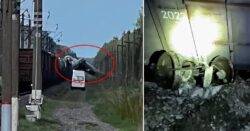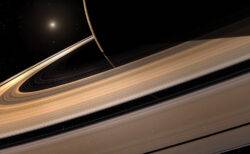Answers (and spoilers) within…
Author: UK News
Gladiators, ready!
The TV presenter has recalled the ‘excruciating’ pain she suffered.
The man was knocked unconscious by a single punch.
‘It’s massive alarm bells for me,’ Cherry shares while discussing Ed’s mental health.
No suspect was in custody as cops released images of a suspect in Atlanta, Georgia, and ordered the public to shelter in place.
The actor has welcomed her first child.
‘I’d rather be writing your favourite show.’
Self-love has *ahem* come a long way.
Just a tiny icon.
‘Bosses have decided to leave it.’
It may be chilly, but the bugs can still grow…
If you’re planning on travelling from Heathrow soon, you’d be wise to check the strike dates.
Ahead of any launch date reveal, a supposed retail employee claims Assassin’s Creed Mirage is out in three months.
‘It looked like a junkie’s carpet.’
Putin’s spies are supposed to be on high alert for Ukrainian special ops on Russian soil ahead of the country’s Victory Day celebrations.
Can Big Sam mount a rescue operation at Elland Road?
Leclerc is on Mercedes’ ‘radar’
Carol McGiffin has cleared up her Loose Women absence (Picture: ITV)
The Loose Women stars have come out in support of Carol McGiffin after she clarified her absence from the show.
It’s been months since the presenter was last seen on the Loose Women panel and the 63-year-old has now confirmed why.
The former Celebrity Big Brother contestant revealed she’s taken a break from Loose Women due to her ‘unjust’ contract.
‘The problem was, ITV were insisting, for the first time since I went back in 2018, that if I wanted to carry on doing the show, I would have to sign a contract that was totally unjust and unworkable for me, so I had to say ‘no thanks,’” she wrote in Best magazine.
She added that she’s been ‘quite upset about it’, and said it was a decision she was ‘forced to make’.
‘No one in their right mind would have signed that contract,’ she continued. ‘And I can’t see a way back from it.’
The Loose Women star has been missing from the panel for months (Picture: ITV)
Her co-stars have backed her all the way though, sharing their support on Instagram.
Brenda Edwards commented: ‘Carol, I always enjoy when you are on as we have such a laugh, but you of course must always do what is best for you! I really hope I get to see you again love you lots lovely lady. Keep Smiling.’
Denise Welch also shared she was ‘gutted’, while Carol’s regular sparring partner Nadia Sawahla said: ‘Miss you smelly poo! Even though we disagreed on most things you’ve always made me laugh my head off!
‘As I’ve always said thank god we weren’t at school together it would have been #carnage !! Big hugs x.’
‘I really miss you, and am so gutted xx,’ added Charlene White.
An ITV spokesperson said in a statement sent to Metro.co.uk: ‘ITV will not comment on or disclose details of individual contracts but all ITV contracts comply with the required employment and HMRC legislation.’
Carol has always been one of the most outspoken Loose Women stars since her very first appearance in 2000.
She took a break from Loose Women in 2013, returning in 2018.
Loose Women airs weekdays at 12.30pm on ITV.
Got a story?
If you’ve got a celebrity story, video or pictures get in touch with the Metro.co.uk entertainment team by emailing us [email protected], calling 020 3615 2145 or by visiting our Submit Stuff page – we’d love to hear from you.
A new Fortnite leak has hinted at yet another Marvel crossover arriving in the battle royale, as soon as Chapter 4 Season 3 kicks off.
Saturn’s rings are its most famous feature (artist’s impression) (Picture: Getty/Science Photo Libra)
Saturn’s rings are eroding – at what could be a cosmic rate of knots.
Since the 1980s astronomers have known the Ringed Planet’s most striking feature is slowly disappearing, falling as icy rain into the atmosphere below.
However, they don’t know how quickly this is happening, or how long they have left.
Enter the James Webb Space Telescope (JWST).
Since revealing its first stunning images in July last year, Nasa’s JWST has already contributed to numerous breakthroughs in the field of astronomy, not least potentially upending the entire timeline of the universe when finding the oldest galaxies ever seen.
Using the JWST and Hawai’i’s powerful Keck telescope, a team from Reading University plans to study the Saturn phenomenon in search of answers.
‘We’re still trying to figure out exactly how fast they are eroding,’ said team leader Dr James O’Donoghue. ‘Currently, research suggests the rings will only be part of Saturn for another few hundred million years.
Saturn, captured by Voyager 2 in 1981 (Picture: Nasa/JPL)
‘We could be very lucky to be around at a time when the rings exist.’
A few hundred million years may not sound like they’re going anywhere fast, but on a cosmic timescale, they could be well into their twilight years.
‘I think it would be fascinating if the lifetime of the rings was only 100million years or so and that their age was billions of years,’ said O’Donoghue, speaking to Space.com. ‘That means we evolved just in time to see them before they vanished.’
Other estimates suggest the rings only appeared 100million years ago – meaning humans are lucky to have been alive to see them during their relatively brief existence in the solar system’s 4.5billion-year history.
Nasa’s James Webb Space Telescope has already provided helped make multiple scientific breakthroughs (Picture: AP)
The rings are thought to be made of billions of small chunks of ice and rock – pieces of comets, asteroids and moons that were broken up by Saturn’s powerful gravity.
They are aligned with the planet’s magnetic field lines, but that strong gravitational pull is drawing the inner rings towards it, which then fall as rain.
However, astronmer’s the Sun’s energy may also have an effect.
Saturn has a long year – it takes 29.5 Earth years to complete one orbit of the Sun, and each season lasts about seven years. Like Earth, Saturn is angled on its axis, meaning at different times of the year the rings will be ‘edge-on’ with the Sun, and at others tilted towards it.
Saturn, captured by Nasa’s Hubble telescope (Picture: NASA/ESA/A/ Simon/OPAL Team)
‘We suspect that when the rings are edge-on with the sun, the ring rain will slow down,’ O’Donoghue told Space.com. ‘And that when they are tilted to face the sun, the ring rain influx will increase.’
To determine if this hypothesis is correct, the team will measure levels of a specific hydrogen molecule in the upper atmosphere which spikes when the icy ring rain is low, and dips when the rain increases.
More: TrendingWhat happens when we die? Scientists may be a step closer to finding outHow to remove MyAI from Snapchat – easy guide to delete chatbotUK residents arrested as global sting shuts down illegal dark web marketplace
‘Saturn may be many millions of miles away, but I believe the key to understanding how fast its rings are disappearing may lie with some of the world’s leading atmospheric scientists in Berkshire,’ said Dr O’Donoghue.
‘Working with the meteorology experts at Reading will give me the opportunity to finally find out what is going on with our giant planetary neighbour.’
MORE : Astronomers uncover mystery of most powerful phenomenon in the universe
MORE : Neptune’s elusive rings pictured by the James Webb Space Telescope
‘We are mentally ready to legally fight this.’
The Liberal Democrats leader also gave his verdict on who should play 007 after Daniel Craig.
Half of local authorities spent just 11p per person on Voter ID awareness campaigns Mirror says Half of local authorities spent just 11p per voter on awareness campaigns for the new Voter ID requirements, research suggests. Of those who declared a specified budget to inform voters of the changes, half of authorities spent only £10,000 or less, according to freedom of information (FOI) requests. A local authority that might typically have around 90,000 electors would see the funding distributed at only 11p per head, research by Unlock Democracy showed. Some 12.2% of authorities had shockingly spent nothing at all on…
Man arrested outside Buckingham Palace A man was arrested outside Buckingham Palace for throwing suspected shotgun cartridges into the Palace grounds. The police have confirmed that the incident is not being treated as terror-related and that the man was arrested on suspicion of possession of an offensive weapon. There were no injuries reported. A controlled explosion was carried out following the incident. The rehearsal for the Coronation on Saturday went ahead as planned. The man was searched and found in possession of a knife and a suspicious bag. The incident is being treated as an isolated mental health issue. The…


























